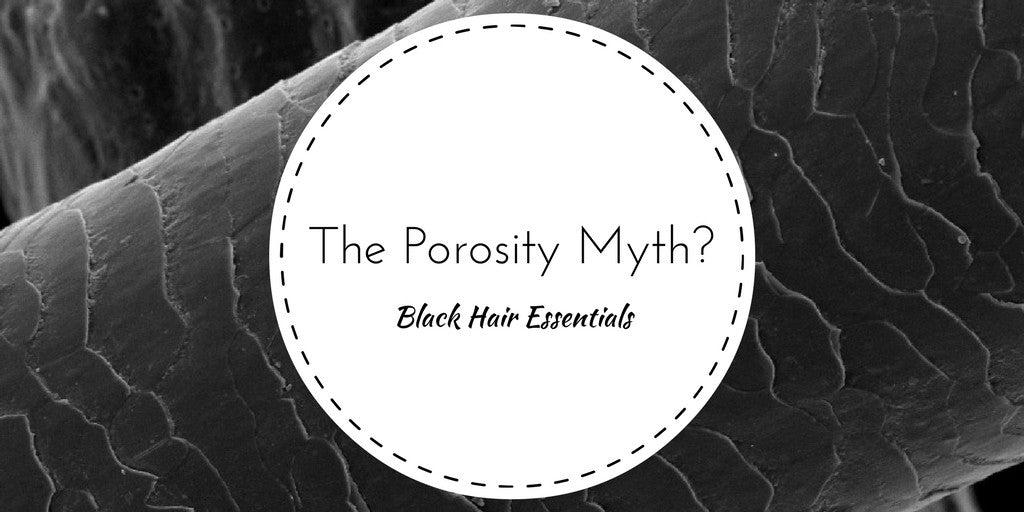
The Porosity Myth?
In these last few years, hair porosity has been a hot topic in hair blogs, magazines, and YouTube videos, and more recently there have been hair products marketed to meet the needs of different porosity types. Hair porosity refers to how effectively the hair can absorb water or chemicals and there are three different porosity types that a person can have; high, normal and low.
So why should it matter what your porosity type is?
This is because high porosity hair affects the hair’s ability to retain moisture whereas low porosity hair struggles to absorb moisture. On the other hand, normal porosity hair is able to retain and absorb moisture.
This difference is caused by the hair’s cuticle (see diagram below).
- In high porosity hair, the cuticles are raised to the extent that the hair’s cortex loses moisture as easily as it takes it in. Hair with this porosity is characterised as dry and rough to touch due to the raised and damaged cuticles.
- In low porosity hair, the cuticles are tightly closed, which makes it difficult to absorb moisture. Hair with this porosity is typically prone to product build-up because of the hair’s inability to absorb moisture easily. It can also take a while for this hair type to become fully saturated with water because of the closed cuticles.
- In normal porosity hair, the cuticles are slightly raised but not too much so it allows for the absorption and retention of moisture. This enables the hair to stay moisturised for longer periods of time.

To find out your porosity type two simple tests are usually carried out:-
Test 1 – The Water Test
This test can be done by placing a strand of hair in a glass of water for up to 10 minutes to see whether it floats to the top, sinks midway or to the bottom of the glass. If the strand floats it means you have low porosity hair. If it sinks to the bottom you have high porosity hair but if it sinks midway you have normal porosity hair.
Test 2 – The Strand Test
This test should be done on clean, dry hair. You place your index finger and thumb on a strand of hair and slowly slide your finger and thumb down the strand. While doing this you feel for unevenness and bumps (i.e. raised cuticles), which is an indicator of high porosity hair. If the strand feels flat then you could have low or normal porosity hair.
Many women use these tests to determine their hair’s porosity level. However, the only problem is they are inaccurate tests for porosity.
The blog post by Natural Haven (read here) and video by Sister Scientist (view here) explain scientifically why the water test is a poor method for determining porosity. To summarise, most hair will float due to the sebum (the natural oil) that coats the hair shaft. Therefore, regardless of whether you carry out the water test on clean hair, it may float because of this residue oil and not necessarily because of low porosity. In addition, the density of your hair and whether it is chemically treated (relaxed or coloured) can cause your hair to sink. In fact, the only reliable way to find out your hair’s porosity type is in a laboratory.
The strand test is also inaccurate because the cuticle is extremely tiny; too tiny to simply feel it between your thumb and index finger. According to Natural Haven the cuticle is two to three-thousandths of a millimetre (source) and its distance can only be measured by a high-powered microscope.
Is it important to know your porosity type?
Before we can answer this question let look at a few facts.
Porosity varies from person to person; it is decided by genetics as well as external factors. Manipulation from shampooing and styling as well as chemical treatments can damage the hair’s cuticle and cause porosity. Environmental conditions such as ultra-violet light (sunlight) and extreme weather conditions can also cause porosity issues. In addition, older hair is more porous than newer hair and would have also been subjected to wear and tear over the years. For that reason, one should consider whether it is possible to have either low, high or normal porosity hair. It makes more sense that an individual should have a mix of different porosity types and without scientific testing, there is no accurate way of finding out.
Going back to the original question of whether it is important to know your porosity type, probably not. The best thing to do is listen to your hair so you understand its needs by paying attention to how it responds to different products and techniques. If you suspect your hair becomes dry because of high porosity, try incorporating extra deep conditioning treatments or using creamy moisturisers that help smooth the cuticle. You can also use the L.O.C method to keep your hair moisturised for longer periods. If you feel like your hair is resistant to moisture, which may be the result of low porosity, decrease the times you moisturise and seal your hair to every other day to prevent product build-up, and use a clarifying shampoo when needed.
Remember that everybody’s hair is different. It is through trial and error that can help you understand what works for your hair. If you consider the uniqueness of everyone’s hair it is too simplistic to define it as low, normal or high porosity. Therefore, such terms should be used as rough guidelines and not as a definitive way to describe your hair.